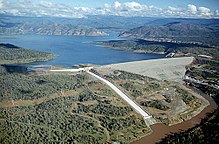
Back سد أوروفيل Arabic Оравілская плаціна Byelorussian Presa d'Oroville Catalan Oroville Dam CEB Oroville (hráz) Czech Oroville Dam German Presa de Oroville Spanish Oroville'i pais Estonian سد اوروویل Persian Orovillen pato Finnish
| Oroville Dam | |
|---|---|
 | |
| Country | United States |
| Location | Oroville, California |
| Coordinates | 39°32′20″N 121°29′08″W / 39.53889°N 121.48556°W[1] |
| Purpose | Water supply, flood control, power |
| Status | Operational |
| Construction began | 1961 |
| Opening date | May 4, 1968 |
| Owner(s) | California Department of Water Resources |
| Dam and spillways | |
| Type of dam | Zoned Earthfill |
| Impounds | Feather River |
| Height (foundation) | 770 ft (235 m)[2] |
| Length | 6,920 ft (2,109 m)[2] |
| Dam volume | 77,619,000 cu yd (59,344,000 m3) |
| Spillway type | Service, 8× gate-controlled |
| Spillway capacity | 150,000 cu ft/s (4,200 m3/s) (service)[3] |
| Reservoir | |
| Creates | Lake Oroville |
| Total capacity | 3,537,577 acre⋅ft (4.363537 km3)[4] |
| Inactive capacity | 29,600 acre⋅ft (0.0365 km3)[5] |
| Catchment area | 3,607 sq mi (9,340 km2)[4] |
| Surface area | 15,805 acres (6,396 ha)[4] |
| Normal elevation | 901 ft (275 m) (spillway crest)[3] |
| Hydraulic head | 615 ft (187 m)[6] |
| Turbines |
|
| Installed capacity | 819 MW[6] |
| Capacity factor | 21% |
| Annual generation | 1,629 GWh (2001–2012)[7] |
| Website water | |
Oroville Dam is an earthfill embankment dam on the Feather River east of the city of Oroville, California, in the Sierra Nevada foothills east of the Sacramento Valley. At 770 feet (235 m) high, it is the tallest dam in the U.S.[8] and serves mainly for water supply, hydroelectricity generation, and flood control. The dam impounds Lake Oroville, the second-largest reservoir in California, capable of storing more than 3.5 million acre-feet (1.1×1012 US gal; 4.3×109 m3).[9]
Built by the California Department of Water Resources, Oroville Dam is one of the key features of the California State Water Project (SWP), one of two major projects passed that set up California's statewide water system. Construction was initiated in 1961, and despite numerous difficulties encountered during its construction, including multiple floods and a major train wreck on the rail line used to transport materials to the dam site, the embankment was topped out in 1967 and the entire project was ready for use in 1968. The dam began to generate electricity shortly afterwards with completion of the Edward Hyatt Power Plant, then the country's largest underground power station.
Since its completion in 1968, the Oroville Dam has allocated the flow of the Feather River from the Sacramento-San Joaquin Delta into the SWP's California Aqueduct, which provides a major supply of water for irrigation in the San Joaquin Valley, as well as municipal and industrial water supplies to coastal Southern California, and has prevented large amounts of flood damage to the area—more than $1.3 billion between 1987 and 1999.[10] The dam stops fish migration up the Feather River and the controlled flow of the river; as a result, the Oroville Dam has affected riparian habitat. Multiple attempts at trying to counter the dam's impacts on fish migration have included the construction of a salmon/steelhead fish hatchery on the river, which began shortly after the dam was completed.
In February 2017, the main and emergency spillways threatened to fail, leading to the evacuation of 188,000 people living near the dam.[11] After deterioration of the main spillway largely stabilized[12] and the water level of the dam's reservoir dropped below the top of the emergency spillway, the evacuation order was lifted.[13]
The main spillway was reconstructed by November 1, 2018, and water releases were successfully tested, up to 25,000 cu ft/s (710 m3/s), during April 2019.
- ^ "Lake Oroville". Geographic Names Information System. United States Geological Survey, United States Department of the Interior. January 19, 1981. Retrieved March 31, 2012.
- ^ a b "Oroville Dam". National Performance of Dams Program. Stanford University. Retrieved March 31, 2012.[permanent dead link]
- ^ a b "Oroville Facilities (FERC Project No. 2100)" (PDF). California Department of Water Resources. January 2005. Archived from the original (PDF) on May 25, 2017. Retrieved February 13, 2017.
- ^ a b c "Oroville Dam (ORO)". California Data Exchange Center. California Department of Water Resources. Retrieved March 31, 2012.
- ^ Ritzema, Randall S.; Newlin, Brad D.; Van Lienden, Brian J. (October 2001). "Appendix H: Infrastructure" (PDF). CALVIN Project. University of California Davis. Archived from the original (PDF) on November 6, 2017. Retrieved January 25, 2014.
- ^ a b Cite error: The named reference
powerwas invoked but never defined (see the help page). - ^ "California Hydroelectric Statistics & Data". California Energy Commission. Archived from the original on February 26, 2018. Retrieved April 26, 2018.
- ^ "Dam, Hydropower and Reservoir Statistics". United States Society on Dams. Archived from the original on March 25, 2012. Retrieved March 31, 2012.
- ^ "Alphabetical List of California Dams (Over 40,000 acre feet)". Civil and Environmental Engineering. University of California Davis. Archived from the original on February 5, 2012. Retrieved March 31, 2012.
- ^ "The Benefits of Dams to Society". USCOLD Newsletter. United States Society on Dams. March 1999. Archived from the original on October 1, 2012. Retrieved September 4, 2012.
- ^ Rodriguez, Olga R.; Thompson, Don (February 12, 2017). "188,000 under evacuation orders near Northern California dam". The Sacramento Bee. Associated Press. Archived from the original on February 23, 2017.
- ^ "Updates: New storms approach, but officials confident Oroville Dam and spillways will hold up". Orlande Sentinel. Retrieved February 23, 2017.
- ^ Cite error: The named reference
LiftOrdersCNBCwas invoked but never defined (see the help page).

